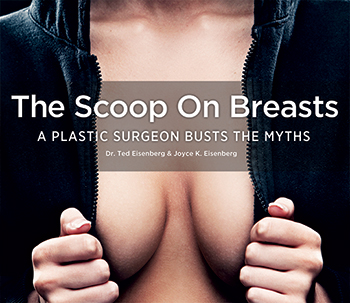Breast Blog
Cosmetic Breast Surgery: Lessons Learned From 56,000 Breasts
I’ve examined a lot of breasts – at least 56,000 – during my career as a plastic surgeon. How’d I get to that number? About 7,000 women have come to me for breast augmentation and breast lift surgery. On average, I see each woman about four times – once before her surgery and three times afterward for post-op visits.
So, 7,000 women x 2 breasts x 4 visits = 56,000. That’s not a problem that would have been on your sixth-grade math homework.
Through the years, I’ve observed every variation in breast size and shape, in breast perkiness and nipple size, and in women’s thoughts about their figure and their cosmetic surgery goals.
If I could sum up what I’ve discovered in one sentence, it would be this: You shouldn’t make assumptions about who gets breast augmentation – and why.
Don’t assume that . . .
. . . many of my patients are exotic dancers. Only about 1 percent of my patients are exotic dancers. The other 99 percent include teachers, nurses, hairstylists, construction workers, doctors, ballroom dancers, stay-at-home moms, company executives, waitresses, fitness trainers, bartenders, cheerleaders, policewomen who want to know how soon they can put their bulletproof vests back on, and women in all branches of the military who email us from Iraq and Afghanistan to set up appointments for when they are back in the United States. This is not a complete list of breast surgery patients.
. . . breast implants are just for younger women. True, the large number  of breast augmentation patients are in their 20s, women who come in because they want to feel more feminine and self-confident. “It’s pretty bad when your 13-year-old sister can already wear your bra,” one woman told me.
of breast augmentation patients are in their 20s, women who come in because they want to feel more feminine and self-confident. “It’s pretty bad when your 13-year-old sister can already wear your bra,” one woman told me.
The second largest demographic is in their 30s. Many women in this age range come in because they liked the fullness of their breasts during pregnancy and want to recapture that look. Others have lost weight and with it their breast volume.
Women 40 and older – and even in their 60s – come in for breast augmentation surgery, too. They want to look as good on the outside as they feel on the inside. They tell me they’ve been taking care of everyone else for years and now they’re ready to do something for themselves. Many have been thinking about breast augmentation for years.
Likewise, my breast augmentation patients are women are all ages. While many come in after they’ve had children or a significant change in weight, others are young women who developed that way.
. . . women get cosmetic breast surgery to attract attention. “Do you want to be proportional, turn heads or stop traffic?” That’s what one of my colleagues asks a prospective breast augmentation patient to see what she has in mind. I’ve tried it. Most women tell me they want their figure to be more proportional, and they want to fit better in their sweaters, bikinis and tank tops. Some comment that they wouldn’t mind turning heads now and then. Not many want to stop traffic. Ironically, some of my patients are policewomen who literally stop traffic – but they would rather not do it with their breasts. [WATCH OUR VIDEO: Breast Implants: Do They Look Fake?]
. . . women get breast implants to make men happy. Only two women out of 6,000 have ever told me that their partner wants them to get implants. Instead, women have consistently told me that their partners love them exactly the way they are, and they are having surgery to make themselves look and feel better. So, sorry guys. Women don’t get implants to please you. That might be an outcome, but it’s not the motivation.
. . . a woman’s breasts are the same on the right and left side. Breasts are sisters, not twins. Few women have identical breasts; the difference might be slight or more obvious. Nipple position, chest diameter, the amount of breast tissue, the location of the breast on the chest wall, and how high or low a breast hangs all contribute to the appearance. With all these variables, it is no surprise that no one has identical twins. [WATCH OUR VIDEO: Correcting Breast Asymmetry]
. . . women need much guidance from me. Women know what they want. During medical training, we are taught that we should know the answers, that we are the authority. But I have discovered that women know best. My job is to listen carefully and to determine if there is a match between their goals and what I can accomplish. I believe I am an expert at figuring that out.
Can You Make Me a Full C Cup?
When women come in for their breast augmentation consultation, most tell me that they want to be a “full C cup.” They want to look proportional, and they think this means they will wear a C cup bra after surgery.
Problem #1: There is no standard bra cup-sizing system.
“C cup” can mean one thing if it’s made by Victoria’s Secret and another if it’s made by Vanity Fair. You might need a B cup in a full-coverage bra and a C cup in a demi bra, even if the same company makes both styles. Your cup size is also affected by how tight you make the band. If you wear it tighter, it will push your breasts deeper into the cup and you’ll need a bigger cup size.
Problem #2: What looks proportional varies from person to person.
Think of “proportional” as a “C look” rather than a “C cup.” To achieve the C look, a 5-foot woman with a small frame might only need a B cup while a 5-foot-8-inch woman with a large frame might need a D cup. Read our blog: “How to Choose Your Breast Implant Size.”
During each breast augmentation consultation, I show prospective patients before-and-after photographs of women who started out similar to them in height, weight, frame size and breast volume. Each  photo notes the size of the implants that I used. Women look at the pictures and tell me, “too big,” “too small” or “just right.” It’s almost like looking through a magic mirror into the future. A woman is almost always consistent with the number of cubic centimeters (ccs) she likes, so I know what size saline or silicone breast implants to order to give her the look she wants on her body. [WATCH OUR VIDEO: How to Choose the Right Size Breast Implants for You]
photo notes the size of the implants that I used. Women look at the pictures and tell me, “too big,” “too small” or “just right.” It’s almost like looking through a magic mirror into the future. A woman is almost always consistent with the number of cubic centimeters (ccs) she likes, so I know what size saline or silicone breast implants to order to give her the look she wants on her body. [WATCH OUR VIDEO: How to Choose the Right Size Breast Implants for You]
When we are finished, women almost always ask, “What cup size will I be?” This is where they can get into trouble. The letter doesn’t matter. They chose a look, and it looked right to them.
Here’s an example of that trouble: A 5’ 9” tall woman with a large frame wanted to be a full C. She liked eight different pictures; all had the same size implants and would give her a C look on her body. When I told her she’d probably wear a D cup, she said, “I don’t want to be a D.” She was stuck on the cup size. She decided to go smaller and was disappointed after surgery.
A woman with a small frame also wanted to be a full C. After voting on the pictures, she asked for her final cup size. I told her she’d probably wear a B. “Can you show me something bigger?” she asked. She had looked at larger implants, but didn’t like the pictures that were even a tiny bit bigger. She decided to stick with the size she liked in the pictures and was happy with her decision.
When Can I Sleep On My Side After Breast Augmentation? Dr. Ted Eisenberg
Side Sleeping After Breast Implants
There’s a myth that after breast augmentation surgery, you’ll need to sleep on your back for a week or longer. Many of my patients believe it, and they are worried that they won’t be able to get to sleep, because they normally sleep on their side or their stomach.
They are not alone. According to th e Better Sleep Council, fewer than 15 percent of people prefer to sleep on their back.
e Better Sleep Council, fewer than 15 percent of people prefer to sleep on their back.
Let’s bust this myth: You don’t have to sleep on your back after breast augmentation surgery. You don’t have to stay up all night to make sure you don’t doze off and turn over onto your stomach. You can sleep any way you want from the night of surgery on, including on your stomach if you’re comfortable enough.
[WATCH OUR VIDEO: Do I Have to Sleep on My Back?]
Saline and silicone breast implants won’t pop if you sleep on them; they are extremely durable and can withstand a lot of weight. In fact, Allergan, an implant manufacturer, tests its implants by exerting 55 pounds of force on them repeatedly, up to 6.5 million times. (That would be equivalent to sleeping on your stomach for the next 17,808 years.)
Just as your contact lens can’t slip behind your eye, your breast implants can’t disappear into your body. They are carefully positioned in a space (a pocket) behind the pectoral muscle. Just like contact lenses, the implants can’t go anywhere because they bounded by muscle and strong tissues. The normal movement in the pocket won’t disrupt your healing.
The only factor limiting your sleep position is comfort. Most women tell me that they are fully comfortable sleeping on their stomach in about three weeks on average. They are comfortable sleeping on their side much sooner.
During the day, do I have to stay in bed?
No, but after surgery you do need time to rest and heal, and you should take it easy for one week. Listen to your body and to me – not to the voice in your head that tells you the laundry needs to be done now. Patients sometimes call me on Day 2 and ask why their breasts feel so sore. When I ask what they did, they tell me they vacuumed their entire house or carried their laundry basket up and down the stairs. After exerting themselves, they realized that they did too much too soon. Leave the vacuum cleaner in the closet for a few weeks; if you need an excuse note, I will be happy to write one for you
When can I take a shower or bath?
You can take a shower the day after surgery, but you should wait until the third week to take a bath. If you soak in a tub, the water could penetrate the incision and cause an infection, whereas the shower water runs off the incision and doesn’t soak into it.
Find out more about breast surgery recovery. Read “What to Expect the First Week.”
The information above is what I tell my patients to do and to expect after breast augmentation surgery: Each doctor has his or her specific postoperative protocol, and it might vary greatly from what you read here. It’s imperative that you follow your doctor’s instructions.
Breast Augmentation: It’s Easier the Second Time Around
Times change. And so may your breast size – especially if you’ve been pregnant or had a significant change in your weight.
During pregnancy, breasts enlarge from hormonal changes and milk production. Afterward, they could return to their original size or get smaller or bigger. Because breasts are made up mostly of fatty tissue, they will get bigger or smaller as you gain or lose weight. In fact, they are often the first indicators. Watch our video about weight change and breast implants here.
Although your breasts may change, your breast implants will remain the same. They don’t need to be replaced every 10 years. I recently changed a woman’s implants after 23 years – she had a child, got smaller and wanted to go bigger – and the implants looked the same as they did the day I put them in.
 About 10 percent of my breast augmentation patients come in for a consultation to get information about making a change. The average time elapsed is about 10 years, though it varies greatly.
About 10 percent of my breast augmentation patients come in for a consultation to get information about making a change. The average time elapsed is about 10 years, though it varies greatly.
They tell me, “I’ve gained a lot of weight, and I’m much bigger than I want to be. I’d like to go a little smaller.”
Or, “After my two children, my breasts got smaller. I just want to get my pre-pregnancy size back – and maybe a little extra.”
Others say, “I went for the gusto 15 years ago. I’ve enjoyed them and they served their purpose, but now that I’m 50something, I just want them a little smaller.”
Like the first time, we look at before and after photographs of women who started out similar to them in height, weight, frame size and breast volume. They tell me, “too big,” too small” or “just right” so I know what size implants to order.
Breast augmentation surgery is easier the second time around. Here’s what’s involved in upsizing or downsizing:
Less discomfort: To change each implant, I go through the same incision that I made initially in the crease beneath the breast. I don’t have to make a pocket beneath the chest muscle for the implant, so there is less manipulation of breast tissue and therefore less discomfort post-op. All you’ll feel is the incision. Consequently, you’ll likely need less medication after surgery for discomfort.
Shorter procedure time: This second surgery takes less time than your initial breast augmentation surgery, which means less anesthesia and a lower possibility of post-operative nausea and vomiting.
Shorter recovery time: You should still take it easy for a week, but you could probably get back to work on the third day because there is much less chance of bleeding. So if your surgery is on a Friday, you could return to work on Monday. First-timers are generally back to work in an office setting in 5 days. And you don’t have to wait until the sixth week to do upper body weights. You can start up again after three weeks.
Quicker results: Because your skin and chest muscles have already stretched to accommodate your implants, the implants won’t start off high like they did the first time. You’ll pretty much see the final result when you get home. After surgery, I’ll have you wear something supportive like a sports bra for three weeks to protect your incision. At that time, you’ll be able to wear and do anything and everything you want. No waiting eight weeks this time to go shopping for new bras and bathing suits.
Timing Your Breast Augmentation Surgery – Dr. Ted Eisenberg
Whether you are planning a wedding or a beach vacation, hoping to get pregnant or lose weight, or entering a sports competition, timing is everything when you are considering breast augmentation surgery.
Taking a Beach Vacation
 Around three weeks after breast augmentation surgery, you can go in a hot tub or swimming pool. At that time, the incision will be healed enough so that water won’t penetrate it and possibly cause an infection. You can go tanning as early as three weeks after surgery, too. Ultraviolet light, whether from the tanning bed or the sun at the beach, can make a scar redder for a longer period of time, so protect your incisions with sunscreen that has a sun protection factor (SPF) of 15 or higher. [WATCH OUR VIDEO: When Can I Tan and Swim]
Around three weeks after breast augmentation surgery, you can go in a hot tub or swimming pool. At that time, the incision will be healed enough so that water won’t penetrate it and possibly cause an infection. You can go tanning as early as three weeks after surgery, too. Ultraviolet light, whether from the tanning bed or the sun at the beach, can make a scar redder for a longer period of time, so protect your incisions with sunscreen that has a sun protection factor (SPF) of 15 or higher. [WATCH OUR VIDEO: When Can I Tan and Swim]
After you get breast implants, it’s best to wait at least eight weeks before making a major investment in new bras and swimsuits. At that time, you will be able to more accurately determine your postoperative size and shape and get a truer fit.
Weight Loss
When you lose weight, it not only reduces the size of your waist and thighs, but it might also reduce the size of your breasts because breasts are made up mostly of fatty tissue. If this happens, you might be left with saggy breasts and stretched skin. If you’re planning to lose 10 percent or more of your body weight, it makes sense to wait until you have reached your goal before you have breast augmentation surgery. To choose breast implants that will make you proportional, you need to know your true starting size.
Wedding Planning
It takes about eight weeks for breast implants to begin to settle into their new size and  shape. If you want to get a true fit, it would be unwise to go wedding gown shopping before then. Since wedding planning calendars usually recommend that you order your gown 8-10 months out, it means your surgery should be a year before the big day.
shape. If you want to get a true fit, it would be unwise to go wedding gown shopping before then. Since wedding planning calendars usually recommend that you order your gown 8-10 months out, it means your surgery should be a year before the big day.
If you can’t plan that far ahead, you could schedule your breast lift or breast augmentation surgery anywhere up to about four months before the wedding. That way, you’ll be able to get your gown’s bodice adjusted at the fitting, which is usually done about 6-8 weeks before the ceremony.
Pregnancy and Breastfeeding
If you are thinking about having a child in the next year or working on it now, I would suggest that you wait because your post-pregnancy breasts might look different from your current pair. During pregnancy, your breasts will enlarge from hormonal changes and milk production. Afterward, they might return to their original size or get smaller, bigger or droopier. You won’t know the verdict until six months after you have stopped breastfeeding or, if you are not breastfeeding, six months after childbirth.
If parenthood is further in your future and you are anxious to enjoy new breasts now, you don’t have to wait. Just understand that you might need a revision after pregnancy.
Training for a Competition
 Three weeks after surgery, it’s OK for you to do aerobic activity (treadmill, stationary bike, etc.), running and lower-body weight training. Women are usually comfortable doing arm exercises (upper-body weights) starting about six weeks after surgery. Among my patients are Triple Crown bodybuilders and kickboxers who go back into competition after getting implants. They start with light training at six weeks and heavier training after eight weeks. None of their implants has deflated. [WATCH OUR VIDEO: Getting Back to the Gym]
Three weeks after surgery, it’s OK for you to do aerobic activity (treadmill, stationary bike, etc.), running and lower-body weight training. Women are usually comfortable doing arm exercises (upper-body weights) starting about six weeks after surgery. Among my patients are Triple Crown bodybuilders and kickboxers who go back into competition after getting implants. They start with light training at six weeks and heavier training after eight weeks. None of their implants has deflated. [WATCH OUR VIDEO: Getting Back to the Gym]
Going Back to Work
Your timeframe for returning to work depends on what your job entails. More than 90 percent of my patients go back to work on the fifth day after their cosmetic breast surgery if they work in an office setting. Women who must use their arms to lift, push or pull (such as nurses, hairstylists or waitresses) normally return to work toward the end of the second week, around the 14th day after surgery.






 CLICK HERE TO BUY
CLICK HERE TO BUY







